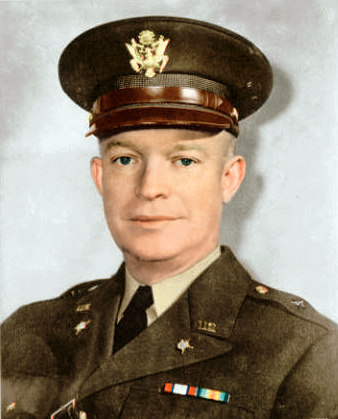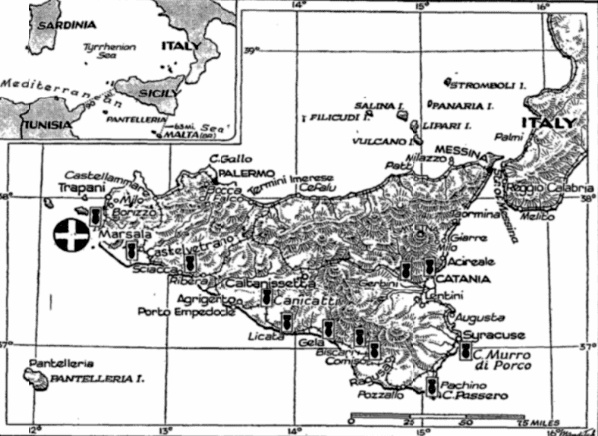Bombs tore Sicily before invasion
Allied fliers ripped airfields, communications and plants in week-long blitz
Allied HQ, North Africa – (July 9, by wireless)
Swarms of Allied bombers maintained their round-the-clock pounding of Axis air bases in Sicily, and formations of fighter-bombers, including new A-36s which are also fitted as dive bombers, hammered transport, communications and industrial plants on the besieged island yesterday as the great Allied aerial offensive centered on Sicily for the sixth straight day.
The new A-36 fighter-bomber, which was developed from North American’s P-51 Mustang fighter, is the newest “plane of all work.” It is used as both a dive and glide bomber and takes part in strafing missions as well. The Mustang is supposed to be the world’s most effective fighter under 15,000 feet and one of the fastest fighters ever built. It is believed that the A-36 is faster than either the Warhawk or Hurricane, principal American and British fighter-bombers used in this theater until the introduction of the A-36. The new fighter-bomber is flown by American squadrons of the Northwest African Air Force.
The key airfields of Sicily at Gerbini, Comiso, Sciacca and Catania were attacked heavily yesterday after being pounded the night before. Hits were scored on a railroad junction and power station by fighter-bombers. A small schooner was sunk off the Sicilian coast by Lightnings that riddled it with cannon shells and machine-gun bullets.
Once again, Field Marshal Gen. Albert Kesselring, chief of the Axis air defenders in the area, held back his main fighter strength. Only about 60 enemy pursuit planes were sighted by wave after wave of British-American planes and of these, 10 were destroyed. Nine Allied planes are missing from the operations.
Since last Saturday, when both the Tactical and Strategic Air Forces of the Northwest African Air Force first concentrated on Sicily, 125 Axis planes have been destroyed. 44 Allied planes have been lost in that period.
A total of 328 enemy aircraft has been shot down in combat since the fall of Pantelleria against 99 Allied planes missing.
One by one, the principal enemy airfields were blanketed with bombs again yesterday, and the central airfield at Gerbini was pounded by strong formations of Liberators. Blast shelters there were “thoroughly covered” by bombs from Flying Fortresses and Mitchells that followed over the target.
About 20 Me 109s attacked the first Fortress formation over the target while the bombers were making their run. One enemy fighter was destroyed. Later in the day, other Fortress groups encountered no opposition. While Fortresses and Mitchells were concentrating on attacks on the main airfield, Marauders escorted by Lightnings assaulted satellite fields. Two of the fields were covered with bomb bursts, several direct hits were scored on aircraft in dispersal areas.
Heavy bombers of the U.S. Air Force based in the Middle East blasted Catania yesterday. The railroad station, factories, locomotive repair shops and warehouses were bombed. A number of explosions and many fires resulted.
A U.S. 9th Air Force communiqué said yesterday that crew members who bailed out of two Liberators of a force which attacked Catania, Sicily, Thursday, “were machine-gunned by enemy fighters,” an Associated Press dispatch from Cairo stated.
Wednesday, U.S. Middle East bombers made a very heavy attack on the Gerbini Air Base and its satellite fields.
Mitchells made their sixth raid in six days on the important Axis landing ground at Comiso, dropping a heavy load of bombs on dispersal areas. These same areas had been bombed earlier by Bostons and Baltimores of the South African Air Force. They started nine fires and scored a direct hit on one large building.
Other formations of Mitchells laid four patterns of bombs across Biscari Airfield and another on administration buildings. The wreckage of the administration building was burning fiercely when the bombers left and there was another large fire on the north side of the field.
Bostons of the Royal Air Force bombed Sciacca Wednesday night. Crews reported a huge orange-colored explosion and fires. Several hours later, Baltimores of the RAF and American Bostons escorted by Warhawks attacked the field and buildings. One explosion was observed in a dispersal area in an olive grove.
About 40 enemy fighters engaged the Warhawks. Three Axis planes were destroyed, one of them by Lt. R. B. Spear of Waterbury, Connecticut.
Wellingtons, the sturdy medium bombers that bear the night aerial offensive, raided the Comiso, Catania and Gerbini Airfields Wednesday night. Two explosions were seen at Gerbini, where administration buildings were set afire. Dispersal areas, runways and headquarters buildings in the southeast corner of the field at Comiso were damaged by bomb bursts.
Fundamentally a fighter, the new A-36 is able to defend itself effectively during bombing and strafing missions. It is equipped with bomb racks and dive brakes. In yesterday’s raids, it made extremely successful attacks on military targets in central Sicily.
The A-36s scored direct hits on a power station, bombed a railroad junction and strafed warehouses and buildings. Two trains were attacked near Licata and Bega Norro and both locomotives were blown up. The converted Mustangs also strafed a convoy of 20 troop-laden trucks, setting at least eight of them afire.
Other formations of A-36s “freelanced” over west-central Sicily. At Canicattì, a hail of small-arms fire from rooftops greeted U.S. planes. Lt. Harry Dorris of Harrisburg, Illinois, reported seeing his tracer bullets going through walls and windows of a radio station there.
Meanwhile, Lightnings sped over southern Italy at treetop height, strafing radio stations at Catania and Cap Assero. One small schooner was sunk and another 100 feet long was damaged 10 miles off Catania. Formations of Lightnings also attacked military targets on Capo Murro di Porco south of Syracuse.
The enemy’s retaliation to all these blows was limited to attempts by two Ju 88s to reach the North African coast. Neither of them made it.

